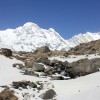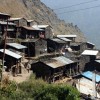Geography
Nepal is a multi-geographic country. It is located in the southern Asia, between the two large countries, China and India. Hence called ‘Nepal is a yam caught between two rocks’. The total area of Nepal is 1, 47,181sq.km, where 92.94% is covered by land and the rest 7.06% is covered by water. It has 2, 926km total land border, where China touches1,236 km and India touches 1,690km. The climate varies from cool summers and severe winters in the north, to subtropical summers and mild winters in the south.
Topographically, it is Terai or flat river plain of the Ganges in south, central hill region, rugged Himalayas in north. The lowest point of Nepal is Kanchan Kalan measuring 70m and the highest point is Mt Everest, which is 8848m.The land used for permanent crops is 0.64%, arable land is 21.68% and others 77.68% according to the record of 2001. The irrigative land of Nepal is 11,350 sq km (1998 est.)Natural hazards of Nepal are severe thunderstorms, flooding, landslides, drought, famine depending on the timing, intensity duration of the summer monsoons.
Nepal is divided into three main physiographic regions-Hilly region, mountainous region and Terai regions. The Terai region supports about 48.4% of Nepal’s population and a lot of the country’s cultivable land and covers 17% of the total area of Nepal. The Terai also includes the big cities: Nepalgunj, Birgunj, Janakpur, Bhairahawa, and Biratnagar. The hilly region covers 68% of the total area of the country and it supports 44.3% of the populations. This region includes Kathmandu, Pokhara, Patan, Gorkha and Jumla. The mountain region covers 15% area of the country. This region supports 7.3% of the populations and the region includes some of the world’s most famous mountains such as Mt. Everest, Annapurna, Gaurishankar, and Machhapuchre.
Nepal is divided into 5 development regions geographically which are-eastern region, central region, mid-western region, western region, far-western region. The Eastern region has a damp climate; on the contrary the far western region has quite a dry climate even during the monsoon seasons. The influence of the monsoon is less in the west and the climate is moderate in the central region. Nepal’s geographical outline is rectangular about 800km long and about 200km wide. Most of the rivers flow southward from the glaciers of Nepal to join up the Ganges in India; several rivers flow from Tibet through deep gorges in the main Himalayan range. There is vast diversity of forests, animals as well as people in this Himalayan kingdom. The Karnali is the longest river of Nepal. Similarly the largest lake is the Rara Lake. The geographic coordinates of Nepal are 28°00N and 84°00E.
Flora and Fauna
Tropical Deciduous Monsoon Forest
The Tropical Deciduous Monsoon Forest includes the plain of Terai and the broad flat valleys and successive hill ranges. The main tree species of this area are Sal (Shorea Robusta), sometimes associated with Semal, Asna, Dalbergia spp and other species. Similarly Pinus rosburghi occurring on the higher ridges of the Churia hills. Churia hill lies at around 1800m of altitude. Tall boorish grassland covered much of the Dun valleys but has now been largely replaced by agricultural settlements. The pipal and the Anyan (ficus bengalensis) are to be noticed with their explicit natural distinctiveness. The forests are the richest area for wildlife like gaurs, buffaloes, four species of deer, tigers, leopards and other animals. The Rhinoceros, swamp deer and hot deer are found in the valley grasslands and two species of crocodile and the and the Gangetic dolphins reside in the rivers. The principal birds are the peacock, jungle fowl and black partridge, while migratory duck and ducks swarm live in the ponds and lakes and big rivers of Terai. Terai forests are full of jasmin, minosa, accecia reeds and bamboo.
Subtropical Mixed Evergreen Forest
The Subtropical Mixed Evergreen Forest incorporates the Mahabharata Lek, which rises to a height of about 2400m.It comprises the outer wall of the Himalayan range. Great rivers such as the Karnali, Narayani, and Sapta Koshi flow through this area into the broad plains of the Terai. Among the tree species-Castenopsis indica in association with Schima wallichii, and other species such as Alnus nepalensis, Acer oblongum and various species of oak and rhododendron are found there. The Rhododendrons cover the higher slopes where deforestation has not yet taken place. Orchids clothe the stems of trees and gigantic climbers smother their heads. The variety and abundance of the flora and fauna are decreasing nowdays. This zone is generally poor in wildlife. The only widely distributed mammals are wild boar, barking deer, serow, ghoral and bears. Different varieties of birds are also found in this zone.
Temperate Evergreen Forest
Northward, on the lower slopes and spurs of the great Himalayas, oaks and pines are the dominant species up to an altitude of about 2400m. Above we find dense conifer forests including Picea, Tusga, Larix and Abies spp. At about 3600 to 3900m, we find rhododendron, bamboo etc. The composition of the forest varies considerably with coniferous predominating in the west and eracaceous in the east. The wildlife of this region includes the Himalayan bear, serow, ghoral, barking deer and wildboar, with Himalayan tahr sometimes being seen on steep rocky faces above 2400m. The red panda is among the most interesting of the mammals found in this zone; it appears to be fairly distributed in suitable areas of the forest above 1800m. The rich and diverse avifauna of this region includes several fabulous and beautiful pheasants, including the national bird of Nepal the Danfe pheasant.
Sub alpine and Alpine Zone
Above the tree line, rhododendron and juniper scrub may extend to about 4200m where the lands are covered by tundra-like association of short grasses, sedge mosses and alpine plants.. This continues up to the lower limit of eternal snow and ice at about 5100m. The mammalian fauna found there is rare. Implausibly, we find Himalayan marmots, mouse hare, tahr, musk deer, snow leopard and also occasionally blue sheep in this area. Until some time ago, the wild Yak and great Tibetan sheep could also be sighted in this region. Birds such as lammergeyer, snowcock, snowpatridge, choughs and bunting with redstarts and dippers are often seen along with streams and rivulets. Yaks are the only livestock which exist at high altitudes. The cheese prepared from the milk is edible for months. The female Yaks are good source of milk for the Sherpas. Nepal is a paradise with a unique bio-diversity & an ideal destination for the naturalists and lovers of wild animals.
Wild life
The forested areas of the Terai are home to tigers and leopards, gaurs (wild ox), elephants, buffalo, and many deer; the deer include chital, or axis, deer (which have white-spotted bodies), sambar (a large Asiatic deer with coarse hair on the throat and strong antlers), and swamp deer. The Lesser Rapti Valley, in south-central Nepal, is one of the last homes to the great Indian rhinoceros (Rhinoceros unicorns).
There are wild animals like-leopards, bears, and smaller carnivores, ravines, and muntjacs (a kind of small deer, also called the barking deer) in small number at the central zone. In the Alpine zone, musk deer – widely hunted for the musk pods they carry, the tahr (a Himalayan beardless wild goat), the goral (any of several goat antelopes, closely related to the Rocky Mountain goat), and wild sheep, snow leopards can be found.
Rhino
Nepal is the habitat of different kinds of animals. Among them one horned rhinos, well known all over the world, are abundant. They are 5 to 6 feet tall, males slightly larger than females, and weigh up to 6000 pounds (2700 kg), and are the only mammal on planet with a horn on its nose. Rhino is one of the endangered species. Humans continue to hunt Rhino smuggling its horn which is said to have medicinal values. Especially it resides in Chitwan National Park. We have also found two horned rhinos in Nepal.
Tiger
There are many species of tigers in Nepal such as-Siberian tiger, Penthera tiger and Bengal tiger. Bengal tigers reside in Nepal with more than 80% of its population living in Nepal. It is an endangered species and found in less than 50 countries. According to the data of WWF, 2006 – less than 5000 Bengal tigers are surviving on the planet.
Elephant:
The Asian elephant is unique, being the only species of its kind. The mammoth, after a few months of human teaching, behaves with patience and understanding. This touching relationship between man and elephant can be observed in Nepal.
Butterflies
There are 11 families of butterflies that can be spotted in Nepal, out of 15 in the world. We find over 500 species of butterflies in Nepal. Britain studied & started to collect butterflies since 150 years ago. Since 1950 Japan have also been involved in the scientific expedition. Later the Natural History Museum at Swayambunath was established in 1974. Because of the diversity in geography, we find various kinds of butterflies in Nepal.
During winter, there is very little activity except for the very common Oriental Species. The Palaearctic species can be found above 3,000 meters, and about 90% Oriental species below 3,000 meters can be spotted.
Within the Kathmandu Valley, the mild climate with day temperatures reaching 18ºC in mid-winter, there are butterflies all the year round. About 20 species in the Kathmandu Valley are on the endangered or vulnerable list.
The best seasons for butterfly watching are late March/April, mid May/ mid June, and late August/September. There are forested areas in the valley which are still remarkable places for butterflies, and they include open country near Chobar and Swyambhu; the base of the hills and forest streams at Godavari, Nagarjun, Budhanilkantha and Sundarijal; the forested hilltops of Phulchowki, Jamachowk and Shivapuri, and the open scrubby bush areas of Nagarkot, Suryavinyak and Chandragiri.National parks & areas without settlement are the ideal locations.
Fossils
‘Shaligram’ is one significant fossil shell found in Nepal. Nepalese believe it to be the embodiment of Vishnu, one of the major manifestations in the Hindu trinity. Puranas like Scanda, Padam and Baraha written around 2,000 years ago, give an exhaustive account of Saligram found in a wide variety of color, shape and size. These fossils can be found not only in the north of the Nilgiri mountain range right up to Damodar Kunda, but also in the waters of the Kaligandaki river right up to Tribeni in Dolal Ghat. However, the most popular belt is on the banks of the Kaligandaki River at Jomsom.
Most of the Nepalese, who are influenced by religious aspect worship the Shaligram for aeons. Shaligram is often placed on a copper plate, water is poured, and then a Puja is performed. In Ridi at Ruru Chhetra, there is a deity on a single huge piece of Shaligram in Rishikesh temple and it measures nearly four feet in height. In legendary stories, Nepal is a country where deities mingle with mortals and Shaligram is a symbol that has contributed to keep the glory and the sanctity of the sublime Himalayas intact.
Medicinal Plants
The diverse geography and climate of Nepal also contributes to various medicinal plants. The Himalayan region is recognized as the breeding ground for such medicinal plants, which are used not only in allopathic pharmacopeias but also in traditional rural therapies, Homoeopathic medicines and Ayurvedic medicines.
A large section of Nepalese population, mainly in rural areas (at times urban as well) depend on ancient practices such as Ayurvedic or herbal practitioners. These plants are useful in pharmaceutical sectors but are getting rarer due to the degrading environment.
Medicinal plants are important components of the various foliage of Nepal where it can be found approximately 49.2% in the tropical zone (up to 1,000 meters), 53.96% in the sub-tropical zone (1,000 – 2,000 m), 35.7% in the temperate zone (2,000 – 3,000 m), 18.9% in the sub-alpine zone (3,000 – 4,000 m), and 7.14% in the alpine zone (4,000 m upwards). There are about 1,400 kinds of medicinal plants utilized by Ayurvedic and traditional healers in Nepal.
Some of the important and well-known medicinal plants of Alpine & sub-alpine zone are: Aconitum Spp., Picrorrhiza scrophularaeflora, Swertia multicaulis, Rheum emodi, Nardostachys jatamansi, Ephedra gerardiana, Cordyceps sinensis, Dactylorhiza hatagirea.
Similarly we can find medicinal plants in Tropical and sub tropical areas like: Terminalias, Cassia fistula, Cassia catechu, Aegles marmelos, Rauwolfia serpentina, Phyllanthus emblica, Ricinus recemosus, Acorus clams, Acacia concinnity, Butte monster etc.
We can find Valeriana wallichii, Berberis, Datura, Solanum, Rubia, Zanthoxylum armatum, Gaultheria fragrautissima, Dioscorea deltoidea, Curulligo orchoidies in Temperate zone.
The Medicinal plants are abundantly found in the Terai region of Nawalparasi, Chitwan, Bardiya, Dhanusha, Mid-hilly Region of Makawanpur, Syanja, Kaski, Lamgjung, Dolakha, Parvat, Ilam, Ramechhap, Nuwakot and in the Himalayan regions of Dolpa, Mugu, Humla, Jumla, Manang, Mustang and Solukhumbu.
The institutions manufacturing Ayurveda medicinal products are Singha Durbar Vaidhya Khana Vikas Samiti, Kathmandu; Gorkha Ayurveda Company, Gorkha; Arogya Bhavan, Kathmandu; Siddha Ayurvedic Pharmacy, Butawal; Pashupati Ayurveda Bhavan, Sarlahi; and Classical Herbal Group, Kathmandu.
Orchids
Nepal is a multi-geographical country and it has a good climate to flourish orchids. Orchid is a beautiful flower and it also extends more enchantment to the trekkers. There are approximately 9797species of orchids all over the world. Among them 363 genera are recorded in Nepal. It is largely found in hilly region. All Nepalese orchids are considered beautiful and most of them especially epiphytic ones have very attractive flowers.
The book “Beautiful Orchids of Nepal” is an attempt to illustrate the diversities found in the structures of 101 wild orchid species of Nepal, along with their descriptions, flowering time, distribution plus color photographs. The book will be useful for all Himalayan plant lovers. The Trekkers are enchanted by the orchid flowers that they find during a simple trekking in the Nepalese territory.
Artificially bred species or hybrids are not included in the 140 species and varieties presented in the book. The pictures are arranged in alphabetical sequence of Latin names in order to express species richness in a genus.
Some genus like Dendrobium has a large share of 32 pictures representing 23 species. Among other genera, the Bulbophyllum (17 Sps.), Cymbidium (12 Sps.) and Coelogyne (8 Sps.) are widely covered in the book. The highest altitudinal record of photographs in the book is from the Everest region at 4,200 m, for a pretty ground orchid Galearis Spathulata. The pattern of altitudinal distribution and flowering period is duly illustrated to determine appropriate season for a given range of altitude.
Rhododendrons
Rhododendron is Nepal’s national flower of and found especially in the hilly areas above 1200m altitude. It blossoms from March to May in the spring season. The mid mountain vertical belt between 2,000 and 4,000 m serves as the ‘wild’ preserve of the rhodododendron, or GURANS and CHIMAL, the two words being used in Nepali.
Below are the major areas for Rhododendron:
1. Langtang national park
2. Makalu Barun national park
3. Milke Danda-Jaljale Himal, a transverse mountain range which separates the two river systems of the Tamur and the Arun
4. Upper Tamur River Valley
There are 30 original kinds of Rhododendron and the one that is widespread throughout the country and not found elsewhere, is Rhododendron lowndesit. It has a lemon or velvety yellow flowers, which are short & well-shaped and are retiring or in pairs on the branch. It can be found near Muktinath and Phoksundo of western Nepal.
Very grand sightings of Rhododendron can be assured in the south west side of Kanchenjunga area & the upper side valley of the Tamur river system. Nine species of Rhododendron can be observed In the upper area of Langtang Valley at around 2000m. The best time is from late March to mid June, and in addition to the Rhododendron, spring blooms of wild poppy, magnolia and primrose will undoubtedly make any trek a memorable one.
Birds
Nepal is a residence of different types of birds. Because of its geographic diversity, we can find various kinds of birds either living in the high altitude of Himalayas or hot environment of Terai. Some birds migrate from Siberia to Nepal. There are more than 850 species of birds on record in Nepal.
Here is a list of some birds of Nepal: Grebes, Pelicans, Cormorants, Darters, Ducks, Geese, Swan Bitterns, Herons, and Egrets, Storks, Ibises and Spoonbills, Flamingos, Osprey, Hawks, Kites and Eagles, Caracaras and Falcons, Pheasants and Partridges, Buttonquails, Cranes, Rails, Crakes, Gallinules, and Coots, Bustards, Jacana, Painted snipe, Oystercatchers, Ibisbill, Avocets and Stilts, Thick-knees, Pratincoles and Coursers, Plovers and Lapwings, Sandpipers and allies, Gulls, Terns, Skimmers, Sandgrouse, Pigeons and Doves, Parrots, Macaws and allies, Cuckoos and Anis, Barn owls, Typical owls, Nightjars, Swifts, Treeswifts, Trogons and Quetzals, Kingfishers, Bee-eaters, Typical Rollers, Woodpeckers and allies, Cuckoo-shrikes, Bulbuls,Kinglets, Leafbirds, Parrot bills, Nuthatches, Buntings, Sparrows, Seedeaters and allies etc.
There is a record of more than than 450 species of birds like peacock, kalij, in the Chitwan national park, 152 species of birds as well as 19 species of water birds in Sagarmatha national park. Rara Lake is a delightful area for birdwatchers, especially during November & April when ducks, cormorants & other birds come during their seasonal migration.
Koshi Tappu Wildlife Reserve is also popular for different kinds of birds. Here we can find endangered species of swamp partridge and most exposed species of Bengal florican and other two species which are at risk; changeable hawk eagle, and dusky eagle owl. About 325 bird species are recorded in this area. Similarly we find different bird species such as the multi-colored Impeyan pheasant (or Daphne, Nepal’s national bird), koklas, blood pheasants among a multitude of other birds in Annapurna conservation area. Approximately 478 species of birds are found there. Lophophorus is a national bird of Nepal, found in the Himalayan areas.
Trees
There are many varieties of trees found in Nepal. Among them Banyan & Pipal have their religious meanings. These trees are found near Hindu & Buddhist holy sites, normally beside temples & shrines. The Eucalyptus can be smelt after a rain as you walk along the street in Kathmandu. The Spruce – an evergreen, coniferous pine tree which took its name from Prussia where it traditionally came from, the Juniper- another evergreen tree & an essential ingredient in the flavoring of gin and used as a diuretic in medicines, Laurel or bay tree and the Cedar & Deodar can be found throughout Nepal, with the cedar often used to make incense. In the western part of Nepal, an indigenous Cypress called Himalayan Cypress is also found. The tree lines in Nepal are up to 5,000 meters, but not above.
There are alpine pastures, alpine meadows, trans-Himalayan steppes, fire-blue pine forests, birch forests, Rhododendron forests, sub-alpine juniper forests, Hemlock and Oak forests, Cypress forests, east Himalayan Oak and Lauren forests, Alder forests and Schima-Castenopsis forests in the Annapurna Conservation Area. Fir, Oak and Rhododendron, West Himalayan Fir and Hemlock forests, Mountain oak, mixed oak and laurel forests, Chir Pine and broad leaved forests are found in the Khaptad National Park.
Similarly, the Alpine pastures, juniper scrub, alpine meadows, dwarf rhododendron, juniper shrubs, fir and larch forests, mixed blue pin and oak forests, laurel and chir pine forests in the Langtang National Park. Dwarf Rhododendron Scrub, Rhododendron shrubberies, Fir and Larch forests, mixed broad leaved forests, East Himalayan Oak and Laurel, and Schim-Castanopsis forests in the Kanchenjunga Conservation Area. In the Makalu-Barun Conservation Area, we can find alpine pastures, alpine meadows, and dwarf rhododendron scrub, fir and birch forests and rhododendron shrubberies, temperate mountain oak, oak and laurel forests, Hill Sal forests. There are alpine mats and scrub, rhododendron and juniper shrubland, fire forests, mountain oak, upper temperate blue pine forests and spruce. Mixed oak and laurel forests in the Rara National Park. In the shey-Phoksundo National Park, alpine pastures, alpine mats and scrub, trans- himalayan steppe, blue pine, birch, rhododendron forests, larch, mountain oak, cedar and cypress forests, deciduous walnut, maple, alder forest, steppe with Euphorbia, Royleana, Grasses and Artemisia can be found.
Nepal Information
Our Top Offers
-
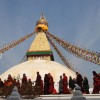
Buddhist Pilgrimage Tour
Lord Buddha was born in the western Nepal. This is the place belongs… Read More -
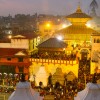
Hindu pilgrimage Tours
Hindu pilgrimage package tour is a perfect Tours package to be spent in… Read More -
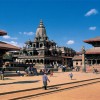
Kathmandu Valley Tour
Nepal is steeped in numerous legends, myths and folklore that are entwined… Read More



